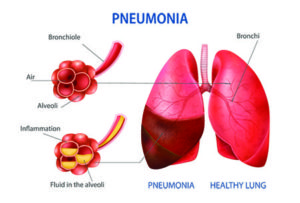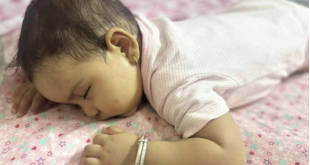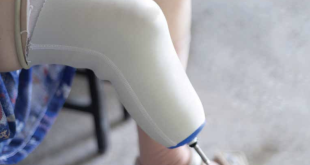 In Nepal, 30% of deaths of children below the age of five is caused by pneumonia, which is double the global rate of 15 percent. A lot of these deaths are caused by a weakened immune system that could have been prevented with good nutrition and childcare.
In Nepal, 30% of deaths of children below the age of five is caused by pneumonia, which is double the global rate of 15 percent. A lot of these deaths are caused by a weakened immune system that could have been prevented with good nutrition and childcare.
Pneumonia is a word that still scares a lot of parents. Around the world, pneumonia kills more children than any other infectious disease. More than 800,000 children die each year due to pneumonia, accounting for 15% of all deaths under the age of five. In Nepal it is the second most common disease causing infant death after diarrhea.
“Pneumonia is simply an infection or inflammation in the lungs.” says Dr. Bharat Chand, a pediatrician at the Armed Police Force Hospital in Balambu. “When there is an infection in the lining of the lungs, it causes disruption in the functioning of the lungs. That is called pneumonia.”
The most common symptoms of pneumonia are fever, shortness of breath, chest in-drawings, etc. However, the symptoms may differ according to the severity of the disease. Less severe cases present common symptoms like coughing, sputum, and fever. But, more severe cases can show more severe symptoms. “We’ve had children come in with severe pneumonia who were showing symptoms like difficulty in breathing, vomiting, stomach pain, fussiness, fainting, and seizures, on top of more common symptoms like fever, shortness of breath, and coughing.” Based on the symptoms. The patients are treated accordingly.
Pneumonia is not caused by a single cause. There are different infectious agents, including bacteria, viruses, and fungi. Some of the most common agents are Streptococcus pneumoniae, Haemophilus influenzae type b (Hib), respiratory syncytial virus, and Pneumocystis jiroveci. The treatment of pneumonia depends on the causative factor of the disease.
Pneumonia is a condition that especially concerns parents. “It is only natural that parents are concerned about their kids. Since kids are vulnerable and unable to take care of themselves, parents often find themselves concerned over pneumonia,” says Dr. Chand. Parents who are careful bring their kids to the hospital in the early stages when the child is only showing common cold symptoms. In these cases, it is easy to treat the patients. However, if the parents bring their kids after the symptoms worsen, it can cause difficulties. “The child of course suffers. When pneumonia is not addressed in a timely manner, the severity increases. When the pneumonia worsens, it can cause an accumulation of pus in the lungs. It can even severely impact the long-term functioning of the lungs. In some cases, the infection may even travel to the heart or brain, as well,” he adds.
Pneumonia is highly prevalent in the developing world, especially in countries like Nepal, due to lack of proper nutrition and sanitation among children. In Nepal, 30% of deaths of children below the age of five is caused by pneumonia, which is double the global rate of 15 percent. A lot of these deaths are caused by a weakened immune system that could have been prevented with good nutrition and childcare. Newborns, whose immune systems are not yet mature, and children whose immune systems have been weakened by lack of proper nourishment are especially vulnerable to pneumonia.
“In the context of Nepal, we need to explore the reasons why pneumonia is so prevalent and the ones who are the most affected by it. In Nepal, different factors like low birth weight, malnutrition, vitamin A deficiency, etc. contribute to its high prevalence,” explains Dr. Chand on the myriad reasons why Nepali children are suffering from pneumonia.
Due to many health and social factors, low birth weight is not uncommon in Nepal. Although the data is not clear, it is estimated that somewhere between 12-32% of children are born with low birth weight. Children who have low weight at birth do not have a well-developed immune system. As such, they are very susceptible to pneumonia.
Malnutrition in children is another big public health issue in Nepal, with over 36% of children under the age of five being malnourished. Children who suffer from malnutrition have a weakened immune system, which is not able to effectively fight off infections like pneumonia.
Exclusive breastfeeding till six months can boost a baby’s immune system, but when that does not happen, it can also reduce the immunity power of a child. Deficiency of vitamin A is also related to pneumonia and chest infections.
Besides nutrition, environmental factors also play a huge role in pneumonia prevention. “We live in a polluted environment and breathe in polluted air. We need to protect the children from the pollution. We can encourage children to wash their hands regularly, teach them cleanliness, and encourage healthy habits, in general. This can also help prevent pneumonia,” states Dr. Chand.
Studies have shown that children who practice regular hand washing before eating and after defecation are 50% less likely to contract pneumonia. Creating a clean and safe environment for kids to live in will reduce the risk of pneumonia and similar infections.
In Nepal, in many rural areas, solid biofuel like firewood is still used for cooking. The pollution caused by burning wood also increases the risk of respiratory infections like pneumonia. Worldwide, household indoor air pollution is responsible for 45% of deaths due to pneumonia in children under the age of five.
Besides nutrition and environmental sanitation, Dr. Chand also recommends keeping children safe from those who may unintentionally infect them. “Another thing we can do is to keep children away from overcrowded spaces, where they can quickly pick up infections. Keeping children away from those who are already sick will help prevent them picking up their disease and infection, as well.” He also recommends keeping children away from smokers, since the passive smoke from the cigarettes can impact the children’s lungs.
And, last but certainly not the least, Dr. Chand recommends vaccinating children fully, in order to protect themselves from different diseases that may lead to pneumonia. “Many of these vaccines are now included in the national guideline itself, so the children must be vaccinated according to the Extended Progress Immunisation (EPI) program of the government. Different vaccines can protect the children from different causes of pneumonia. PCV10, i.e. the pneumococcal vaccine, protects them from the bacteria that causes pneumonia. HiB vaccine (Haemophilus influenzae type B vaccine) protects against one of the viral causes of pneumonia. Vaccines for whooping cough and similar respiratory infections also help prevent pneumonia. All these vaccines are included in the government’s EPI program.”
Besides these vaccines provided by the government, if patients are willing to pay more money, vaccines like Prevnar and yearly influenza vaccines are also available in private hospitals. They might be a bit expensive, but they can also help prevent pneumonia.
There are many causes of pneumonia—bacterial, viral, fungal—and many steps that we can take to protect our children from this disease. Many of these preventive measures, such as improving the public health system, improving nutrition for mother and child, and reducing pollution require systemic changes. But, there are many steps that parents themselves can take to protect their little ones, such as building clean and healthy habits, providing good nutritious food, wearing masks in public places and polluted environments, and preventing their children from coming in contact with sick people. And, most importantly, parents can bring their children to the hospital or nearby healthcare center whenever they start showing symptoms of respiratory illness. Early diagnosis of pneumonia leads to early treatment and prevents long-term complications.
 Medicosnext
Medicosnext




